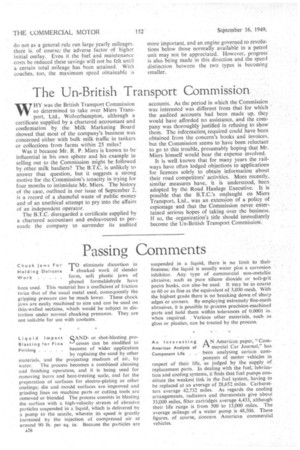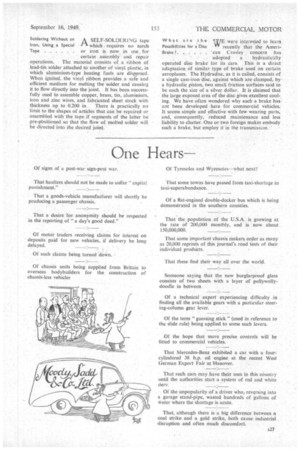Passing Comments
Page 28

Page 29

If you've noticed an error in this article please click here to report it so we can fix it.
TO eliminatedistortion in chucked work of slender form, soft plastic jaws of phenol formaldehyde have been used. This material has a coefficient of friction twice that of the usual metal used, consequently the gripping pressure can be much lower. These chuck jaws are easily machined to size and can be used on thin-walled secticins, which would be subject to distortion under normal chucking pressures. They are not suitable for use with coolants.
Chuck Jaws For Holding Delicate Work
Liquid Impact gANDor shot-blasting proBlasting for Fine L.)cesses can be modified to Finishing become of wider application by replacing the sand by other materials, and the projecting medium of air, by water. The process becomes a combined cleaning and finishing operation, and it is being used for removing burrs and heat-treating scale, and for the preparation of surfaces for electro-plating or other coatings; die and mould surfaces are improved and grinding lines on machine parts or cutting tools are removed or blended The process consists in blasting the surface with a high-velocity stream of abrasive particles suspended in a liquid, which is delivered by a pump to the nozzle, wherein its speed is greatly increased by the injection of compressed air at around 90 lb. per sq. in. Because the particles are
suspended in a liquid, there is no limit to their fineness; the liquid is usually water plus a corrosion inhibitor. Any type of commercial non-metallic abrasive, such as pure silicon dioxide or soft-grit pecan husks, can also be used. It may be as coarse as 60 or as fine as the equivalent of 3,000 mesh. With the highest grade there is no breaking down of sharp edges or corners. By employing extremely fine-mesh abrasives, it is possible to process precision-machined parts and hold them within tolerances of 0.0001 in. when required. Various other materials, such as glass or plastics, can be treated by the process.
An Interesting A N American paper, " ComAmerican Analysis of rm. mercial Car Journal," has Component Life . . been analysing certain com ponents of motor vehicles in respect of their life, as judged by the supply of replacement parts. In dealing with the fuel; lubrication and cooling systems, it finds that fuel pumps constitute the weakest link in the fuel system, having to be replaced at an average of 28,652 miles. Carburetters average 42,732 miles. As regards the cooling arrangements, radiators and thermostats give about 33.000 miles, filter cartridges average 4,433, although their life range is from 500 to 15,000 miles. The average mileage of a water pump is 48,506. These figures, of course, concern American commercial vehicles. Soldering Without an A SELF-SOLDERING tape Iron. Using a Special which requires no torch Tape or iron is now in use for
certain assembly and repair operations. The material consists of a ribbon of lead-tin solder attached to another of vinyl plastic, in which aluminium-type heating fuels are dispersed. When ignited, the vinyl ribbon provides a safe and efficient medium for melting the solder and causing it to flow directly into the joint. It has been successfully used to assemble copper, brass, tin, aluminium, iron and zinc wires, and fabricated sheet stock with
thickness up to 0.200 in. There is practically no limit to the shapes of articles that can be repaired or assembled with the tape if segments of the latter he pre-positioned so that the flow of molted solder will be directed into the desired joint. What are the INE were interested to learn Possibilities for a Disc " recently that the Amen Brake can Crosley concern has . adopted a hydraulically operated disc brake for its cars. This is a direct adaptation Of similar type of brake used on certain aeroplanes. The Hydradisc, as it is called, consists of a single cast-iron disc, against which are clamped, by a hydraulic piston, two small friction surfaces said to be each the size of a silver dollar. It is claimed that the large exposed area of the disc gives excellent cool-, ing. We have often wondered why such a brake has not been developed here for commercial vehicles. It seems simple and effective with few wearing parts, and, consequently, reduced maintenance and less liability to chatter. One or two foreign makes embody such a brake. but employ it in the transmission.'




















































































